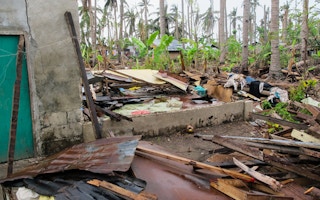More frequent floods, storms, heat waves, and droughts are connected to greater extremes in temperatures and rainfall, according to Global Increase in Climate-Related Disasters, a new study from Independent Evaluation at the Asian Development Bank.
In a global analysis spanning the last four decades, the study shows that the rise in climate-related disasters is linked not only to people’s increased exposure and vulnerability, but also to changes in temperature and rainfall resulting from rising greenhouse gases.
The study, published as an ADB Economics Working Paper, is timely given the recent warnings by the US National Oceanic and Atmospheric Administration and other climate monitors that global temperature is already halfway to the “two degree warming” threshold for limiting catastrophic climatic impacts.
Released just ahead of the United Nations climate change meetings in Paris in December, these findings add fresh urgency to cutting emissions.
Three implications are inherent in these findings:
- First, climate impacts are not just concerns for the distant future, but are already being felt.
- Second, heavy damages from climate-related disasters are being incurred by all countries, rich and poor, although the death toll has been especially high among the poor who are more likely to live in harm’s way, such as in flood-prone areas.
- And third, it is a mistake to think that climate action—such as switching from dirty fossil fuels to cleaner renewable sources—will hold back economic growth.
“Policymakers and economic advisors have long held the view that climate action is a drain on economic growth”, says Vinod Thomas, coauthor of the study and director general of Independent Evaluation at ADB. “But the reality is the opposite: the vast damage from climate-related disasters is an increasing obstacle to economic growth and wellbeing”.
The study finds that the frequency of intense climate-related disasters over the past four decades is associated with population exposure, measured by population density and with people’s vulnerability to these events, measured by their income levels. It also confirms the importance of climatic changes in making hazards more extreme: deviations in precipitation are positively linked to disasters from floods and storms.
“The evidence is telling us that hazards of nature are increasingly turning into disasters because of human action”, says Ramon Lopez, co-author of the study and professor of economics at the University of Chile. “We found that disasters are exacerbated by climatic impacts at the local level as well as by climate change globally”.
Disaster risk estimates in the study illustrate some potentially big impacts. For a country facing the average of nearly one climate-related disaster a year, if CO2 concentrations continue to rise by the current annual rate of 2 parts per million (or by 0.5 per cent) from the already high 400 parts per million, that would see a doubling of the frequency of floods and storms in 17 years.
The three countries the study reviewed at high risk of climate-related disasters, Indonesia, the Philippines and Thailand, by one definition, have on average seven of these episodes a year. Any further increases in CO2 would hit these countries hard, as would be the case for other disaster-prone countries such as Bangladesh, Costa Rica and Mauritius.
Scientific evidence has already established the association between greenhouse gas emissions and changes in climatic conditions. The findings in this study go further by adding a connection between climate change and the frequency of intense natural disasters—after taking into account the contribution of density of population and people’s income.
As such, the study aims to focus attention on the human actions related to natural disasters. “The implication is that a big part of the actions for disaster risk reduction will have to be preventive in nature, in addition to those that are reactive, such as relief and rebuilding efforts”, says Lopez. “Prevention in turn will need to be in good measure to climate mitigation and climate adaptation.”
The first half of this decade featured deadly climate-related disasters, among them the great floods in Thailand in 2011, Hurricane Sandy in the United States in 2012, and Typhoon Haiyan in the Philippines in 2013. The year 2014 was the earth’s warmest in 134 years of recorded history, and 2015 could well turn out to be even hotter. While scientists hesitate to link any one of these occurrence to climate change, the association is compelling.
In the run-up to the Paris climate change meetings, a great deal of attention is focused on how much countries must do to stave off the worst impacts of climate change.
“The relationship between climate change and the frequency of intense natural disasters provides an immediate and tangible reason why actions by countries and the global community must be urgent and decisive,” says Thomas.
The report can be downloaded here.










